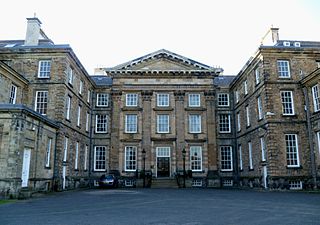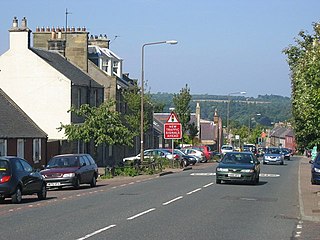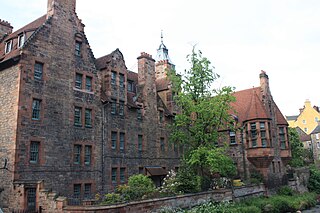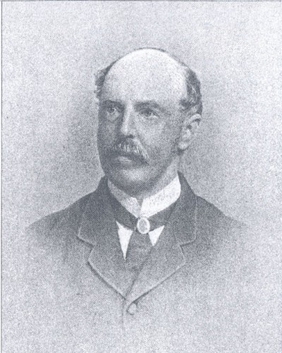
Midlothian is a historic county, registration county, lieutenancy area and one of 32 council areas of Scotland used for local government. Midlothian lies in the east-central Lowlands, bordering the City of Edinburgh, East Lothian and the Scottish Borders.

The Dean Cemetery is a historically important Victorian cemetery north of the Dean Village, west of Edinburgh city centre, in Scotland. It lies between Queensferry Road and the Water of Leith, bounded on its east side by Dean Path and on its west by the Dean Gallery. A 20th-century extension lies detached from the main cemetery to the north of Ravelston Terrace. The main cemetery is accessible through the main gate on its east side, through a "grace and favour" access door from the grounds of Dean Gallery and from Ravelston Terrace. The modern extension is only accessible at the junction of Dean Path and Queensferry Road.

Dalkeith Palace is a country house in Dalkeith, Midlothian, Scotland. It was the seat of the Dukes of Buccleuch from 1642 until 1914, and is owned by the Buccleuch Living Heritage Trust. The present palace was built 1701–1711 on the site of the medieval Dalkeith Castle.

Gorebridge is a former mining village in Midlothian, Scotland.

Vogrie Country Park in Scotland is managed by Midlothian Council. It consists of a woodland estate surrounding the Victorian Vogrie House.

Mortonhall is an area of Edinburgh, Scotland, on the south edge of the city.

Lauriston Castle is a 16th-century tower house with 19th-century extensions overlooking the Firth of Forth, in Edinburgh, Scotland. It lies on Cramond Road South, between Cramond, Davidson's Mains, and Silverknowes. The substantial grounds, Lauriston Castle Gardens, operate as a local park. The castle was bequeathed to the Edinburgh Corporation and hosts the Lord Provost's annual Garden Party. The house is a Category A listed building and the grounds are included in the Inventory of Gardens and Designed Landscapes in Scotland.

Clan Dewar is a Scottish clan.

Hawthornden Castle is located on the River North Esk in Midlothian, Scotland. The castle lies a mile to the east of Roslin at grid reference NT287637, and is just downstream from Roslin Castle. Hawthornden comprises a 15th-century ruin, with a 17th-century L-plan house attached. The house has been restored and now serves as a writer's retreat. Man-made caves in the rock beneath the castle have been in use for much longer than the castle itself.

Pathhead village is a conservation area in Midlothian, Scotland.

Arniston House is a historic house in Midlothian, Scotland, near the village of Temple. This Georgian mansion was designed by William Adam in 1726 for Robert Dundas, of Arniston, the elder, the Lord President of the Court of Session. The western third of the house was added by John Adam, son of William and brother of Robert Adam, in 1753.

Dewartown is a small hamlet in Midlothian, Scotland.

Mavisbank is a country house outside Loanhead, south of Edinburgh in Midlothian, Scotland. It was designed by architect William Adam in collaboration with his client, Sir John Clerk of Penicuik, and was constructed between 1723 and 1727. The first Palladian villa in Scotland, it is described by Historic Scotland as "one of Scotland's most important country houses". It was altered in the 19th century, but suffered decades of neglect in the 20th century. The interiors were gutted by fire in 1973, and the house remains a ruin. As of May 2009, plans exist to partially restore the building and manage the estate as a community asset.

Regent Terrace is a residential street of 34 classical 3-bay townhouses built on the upper south side of Calton Hill in the city of Edinburgh, Scotland. Regent Terrace is within the Edinburgh New and Old Town UNESCO World Heritage Site inscribed in 1995.

Arthur George Sydney Mitchell was a Scottish architect. He designed a large number of bank branches, country houses, churches, and church halls. His most significant commissions include the housing developments at Well Court and Ramsay Garden, both in Edinburgh.

Craig House is a historic house and estate located on Easter Craiglockhart Hill, between the Craiglockhart and Morningside areas of Edinburgh, Scotland. Old Craig House dates from the 16th century, and succeeded an earlier building. In the late 19th century it was purchased by the Royal Edinburgh Hospital, and the site was developed as Craig House Hospital, a psychiatric hospital, including substantial new buildings. Following refurbishment, the site was opened in 1996 as the Craighouse Campus of Edinburgh Napier University.
Events from the year 1937 in Scotland.
Ernest Arthur Oliphant Auldjo Jamieson FRIBA MID (1880–1937) was a Scottish architect operating in the early 20th century. He specialised in country houses, largely for wealthy family friends. From after the First World War he also got many commissions from local authorities for social housing, plus several commissions related to hospitals and asylums.

St Mary's Monastery is an ecumenical Christian spirituality and retreat centre in Kinnoull, Perth, Scotland. It was built in 1868 by the Redemptorists. Until 1971, it also served as a novitiate for the Redemptorists. In 1870, the church and shrine, Our Lady of Perpetual Help, was built within the grounds. It is located on Hatton Road, to the east of Kinnoull, on the edge of Kinnoull Hill, overlooking the city of Perth. The building has been registered as a category B listed building by Historic Environment Scotland, and was the first Roman Catholic monastery established in Scotland since the Reformation.

Andrew Heiton was a Scottish architect. He designed several notable buildings in Scotland, mostly railway stations and country houses.



















